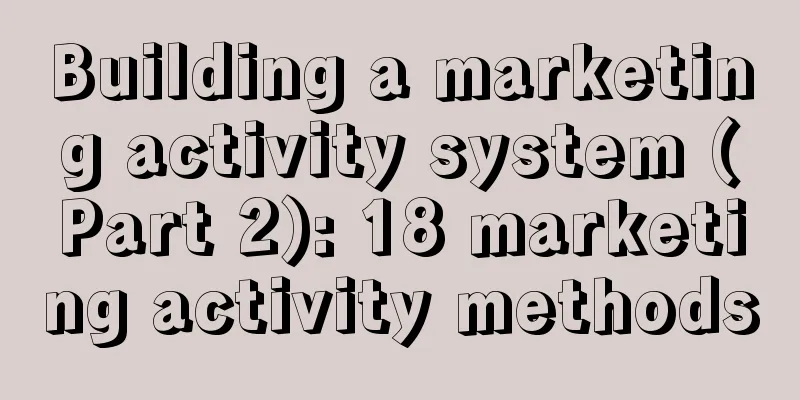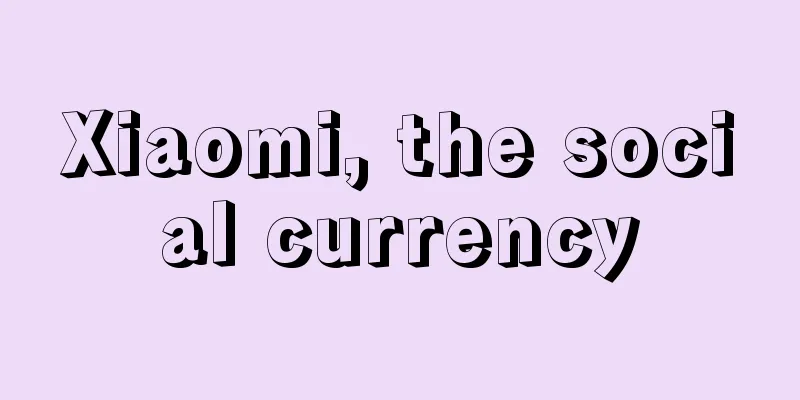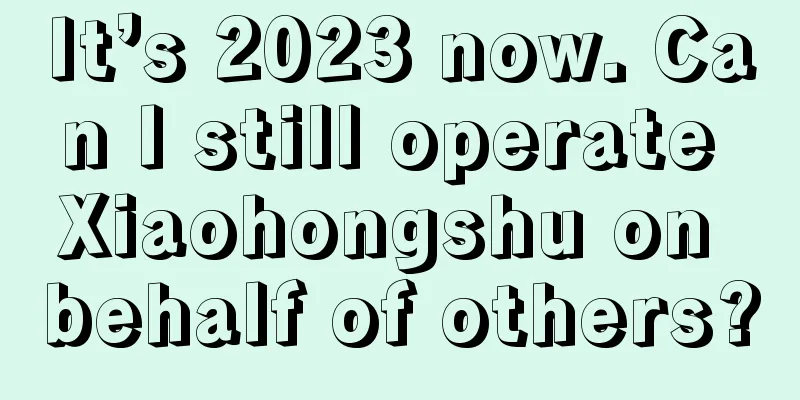Building a marketing activity system (Part 2): 18 marketing activity methods

There are many ways to conduct marketing activities on the market, and most of them can be used in different industries. For example, lucky draw activities can be used in e-commerce products (such as Jingdong Vipshop), travel products (such as Didi Chuxing and AutoNavi Maps), information products (such as Toutiao and NetEase News), game products (such as Genshin Impact Egg Party, etc.), and financial products (such as Anyihua 360 IOU). However, the applicable marketing activities will be quite different depending on the product form (such as e-commerce and reading information) and the industry (financial industry and catering industry). For example, for information products such as WeChat Reading (or Toutiao) and e-commerce products such as Vipshop, the marketing activities available to the former are limited by the product form, and are obviously much fewer. The full discount and flash sale activities commonly used in e-commerce are not very suitable for information products. E-commerce products should be an industry with relatively more marketing activities in the entire industry. Different marketing activities can be carried out according to different scenarios or life cycles of users or products. The following is the marketing campaign gameplay that I sorted out when I was working on marketing campaign products at Mashang Consumer Finance in the early years. I designed corresponding marketing campaign gameplay according to the user's life cycle stage. Marketing activities for financial products: Below we will briefly introduce how to play 18 of the more common types of activities. The gameplay of various mobile games/web games/PC games is not within the scope of this article. 1. Coupon redemption activityChapter 1.1 briefly introduces the prize system - coupons. Assuming that my coupon prizes have been configured, how can I distribute them to users? In fact, there are many ways and methods. Automatic coupon delivery After a new user completes registration in the product, the system automatically issues coupons. Of course, this registration event can also be adjusted according to the behavior or event that the platform or product wants the user to complete. For example, real-name or card binding or credit or account activation or browsing the product list page for XX seconds or completing the first order payment or confirming the receipt of the first order. Of course, the system can also automatically deliver coupons every time an action is completed or an event is triggered. A partial screenshot of the background activity configuration page is as follows. Manual coupon collection users need to manually collect coupons on the app homepage, coupon collection center, product list, product details page, or activity page. This is mainly to promote user login and activity. After all, users cannot see and collect coupons if they do not log in to the product or enter the corresponding page. 2. Activities of bringing new employees togetherThe activity of bringing in new customers by bringing in old customers can also be called MGM, or Member Get Member activity, which is a typical fission and new customer acquisition activity. Pinduoduo's "Get Cash Every Day" activity, WeChat Reading's "One Answer Every Day", and Hua Xiaozhu's "Get Millions of Cash Every Day" are all typical MGM activities. It can help products quickly obtain traffic and user growth at a limited cost. The old-to-new activity is actually an evolution of the early promoter system, which was almost a standard feature of major PC game manufacturers during the heyday of PC games in 2005. Its method is relatively simple. Each promoter (the inviter) has a unique ID or invitation code. When a new user registers in the game, as long as he fills in the invitation code, the system will establish a binding relationship between him and the promoter. For every new player that a promoter invites to register, reaches level XX, and tops up XX yuan, he or she can get the corresponding reward. The reward is mainly promotion commission, and the promoter can withdraw cash when the commission reaches a certain threshold. Of course, new players who fill in the invitation code will also receive additional gift packs, which mainly include in-game currency and props gift packs. Later, this gameplay continued from the PC Internet era to the mobile Internet era, and it was given a more high-sounding name called distribution fission. Of course, some companies call it "old customers bring new customers" and some call it the MGM system, but the essential principle is the same: old customers invite new customers. Rewards are given according to different nodes of the new users in the product. Of course, this gameplay is also constantly keeping pace with the times, and is constantly being iterated and improved. After listening to these introductions, many people may think that distribution fission should not be difficult, but in fact it is not. Building a simple distribution fission system is relatively easy. The following figure is the simplified version of the background configuration page of the distribution fission system made by our company recently. It does not look complicated. But if you want to make this gameplay perfect, you still need to spend a lot of thought and energy. A few years ago, when I was working on the MGM system at Mashang Consumer Finance, there was a 6-person project team (development + product + operation + testing) who treated it as a long-term project. Facts have also proved that the customer acquisition cost of this gameplay is extremely low and the cost performance is extremely high. For the sake of confidentiality, I will not talk about the specific data here, I will only talk about the general gameplay. The following is a partial screenshot of the MGM activity background configuration page. Among them:
After more than a year of iteration, the MGM system has become modularly and visually configured. That is, after the UI displays the activity page image, the operator can edit and generate an activity URL link. There is almost no need for front-end and back-end developers to write code to implement the MGM function, and the overall data of MGM activities has been steadily increasing. In fact, fission coupons can also be regarded as a replica of the activity of bringing in new customers. For example, user A obtains a 20 yuan coupon. A shares the coupon with BCD and all three of them receive the 20 yuan coupon. At this time, the face value of A's coupon will fission into 80 yuan. The design of the MGM event could take up an article of more than 6,000 words if I were to describe it in detail, so I will just stop here. The following is a list of features from an iterative version I made, for your reference only. 3. Lucky Draw ActivitiesAs the name implies, users can obtain lottery chips after completing certain events or behaviors, and then obtain lottery qualifications by consuming chips. Early lottery pages were basically large turntables, and later they evolved into various fancy forms such as nine-square grids, slot machines, scratch cards, etc., but their essence is lottery. The following is a partial screenshot of the backend configuration page for a lucky draw event when I was working on a B2B e-commerce business for alcoholic beverages. The lucky draw qualification here is based on the order amount and number of orders, and the prizes are various coupons and cash red envelopes that are configured in advance.
4. Collection ActivitiesThe most common collection activity is Alipay's annual "Collect Five Blessings" activity. At the same time, some novel ways of playing have also emerged, such as collecting dragon-shaped fragments in the Year of the Dragon and then piecing together a picture of a Chinese dragon. Users who complete the collection will share the prize pool or be eligible to participate in the lottery. Laymen watch the excitement, experts watch the door. Product managers will first analyze the business flow of this lucky event, analyze the overall business process and then break down the functional modules and function points of the front and back ends, and how many corresponding pages there are. Putting aside other branch processes, we can think about how the core business process of the entire activity should or can be implemented in the back-end system. Collection process:
Synthesis process:
Prize drawing process:
Overall, Alipay’s “Five Blessings” campaign should be much more grand and huge than what I described, such as the brand’s card management and UI elements, such as the lottery and synthesis-related animations, such as the red envelope settings and fund sharing, as well as the corresponding data statistics, risk control management and underlying architecture, etc. Small companies are really not recommended to carry out such activities with high input and low output. If small companies must carry out such collection activities, I think the collection and synthesis process is indispensable, but the synthesis process and the lottery process seem to be integrated together, eliminating the step of issuing lottery qualifications, that is, collecting 5 cards and immediately giving away other unified and fixed prizes, such as a cash red envelope of 8.88 yuan. 5. Question-answering activitiesThe earliest quiz activities were a common way of playing in online games. For example, a quiz activity would be started at a scheduled time every day. Players could enter the activity and participate in answering questions. They could get rewards after answering XX questions correctly or passing the level. The purpose of this activity is mainly to attract players to go online and promote activity. Secondly, many players will offer rewards or search for XX game quiz activity question bank on the Internet in order to get high scores, thereby increasing the search popularity and exposure of the game. This may also be something that the game activity designers did not expect. Later, this activity was transplanted into many products, such as WeChat Reading. At the same time, the gameplay was upgraded to allow users to compete in answering questions. Combined with the question rankings, it can greatly arouse users' competitive spirit, satisfy their vanity and promote activity. Guessing with prizes can actually be considered an advanced way of playing quiz activities, where users can "test" the relevant results. Then, through personalized content, users are attracted to forward it to their friends circle or even swipe the screen, thereby promoting the exposure and dissemination of the product.
6. Check-inYou can get rewards by checking in every day. You can get more rewards by checking in continuously. The rewards can be medals, points or other prizes. This gameplay is more suitable for improving user activity and increasing user stickiness. It is usually more common in fitness, reading, shopping and other applications.
7. Full discounts, full discounts, full giftsThese three activities are the most common forms of activities within e-commerce products, without a doubt. Full reduction activities: A common example is that if you purchase more than XX items or more than XX yuan, the total order price will be reduced by XX yuan, or the total order price will be reduced to XX yuan. Reduction is more common, while reduction is less common (somewhat similar to Taobao's shopping cart price change, but the system automatically reduces to eliminate the need for manual price changes). It is a bit like selling a combination of products at a reduced price, but without the trouble of configuring multiple combination products. Of course, there are two subdivisions of full discount: repeated full discount and step full discount. Full discount activities: A common practice is that if you purchase more than XX items or more than XX yuan, you will get XX discount on the total order price. To avoid too high a marketing discount, an upper limit on the discount amount is usually set when setting up an event. For example, if the discount is 20% off for orders over 10,000 yuan, the upper limit is 1,200 yuan, so the actual amount paid by the customer should be 8,800 yuan instead of 8,000 yuan. To use an inappropriate but easy-to-understand metaphor, it means that the customer is a novice but loves to play, and wants to organize activities but is reluctant to give the discount to customers. Full gift activities: A common way is to buy XX items or XX yuan of goods and get XX items of a certain product for free, or XX items of product A and B for free. Later, a more flexible way of playing was derived. The gift pool of free goods has M kinds of gifts, and users can choose N kinds (N<=M). The gift M here can also be a coupon or a third-party benefit. For example: When the organizer was sorting out the warehouse or taking inventory, he found 4 kinds of slow-moving goods that were about to expire, including 400 packs of ham, 800 packs of instant noodles, 600 packs of snail noodles and 1,200 boiled eggs. If one of each product was taken, only 400 gift packs could be configured, which would not be able to maximize the use of these slow-moving goods. At this time, if you choose 3 out of 4 gifts, you can configure 1,000 gifts. While expanding the beneficiary group of the activity, you can also deal with obsolete products to a greater extent. Of course, there are still loopholes in the above example, because the actual selling price of each of the four gifts cannot be guaranteed to be exactly the same. When customers have difficulty making choices, they will choose the product with the highest price, such as choosing all sausages. This is unfair to subsequent customers who participate in the event and will not be attractive enough. At this time, you can add another restriction condition that is, you can select a maximum of X items for each of the four products. That is, you can only select a maximum of 3 items from the four gifts ABCD to control the total quantity, and set a limit on the quantity of gifts ABCD separately, such as a maximum of 2 items for AC and a maximum of 1 item for BD. Of course, the corresponding cost is that the background configuration and development implementation will be more complicated. The first two types of activities will involve the difference between the amount payable and the amount actually paid, and the discount amount needs to be allocated proportionally to the participating products. For the full gift activity, the value of the gift needs to be allocated to the corresponding products. 8. Purchase restriction activitiesPurchase restrictions refer to limiting the number or quantity of purchases of a certain SKU within a certain period of time. But some readers may ask, as a seller or platform, shouldn’t the more the better? Why do we need to set purchase restrictions? In fact, if you think about it carefully, it is not difficult to find that purchase restrictions exist in real scenarios. For example, if the iPhone 16 is released on JD.com, if there is no purchase restriction, the limited products may be snatched up by a very small number of buyers or scalpers, and users who really need it may not be able to buy the new products, affecting the user experience. Simply put, the platform or seller hopes that this relatively scarce or extremely attractive product can be purchased by 100 customers, each of whom buys one, so that the product or platform will have more traffic, rather than having 100 units purchased by a rich person or scalper. In addition to the traditional restrictions on the number of purchases and the quantity of purchases, purchase restrictions should also have risk control dimensions, which basically involve risk control models, big data and algorithms, such as the dimensions of delivery address, mobile device IEME, and delivery mobile phone number. Many of the iPhones included in Pinduoduo's 10 billion yuan subsidy are worth buying, so many users will try to take advantage of them. However, Pinduoduo's risk control mechanism will identify "speculative" users and automatically cancel their orders. 9. Flash SalesSome readers may ask, both purchase limits and flash sales limit the number and quantity of purchases customers can make during the event period. It feels like the two are the same event, so why do some platforms offer two different types of events? In fact, there are some differences between the two, as follows:
Merchants launch limited-time, low-price flash sales to attract customers to the store, quickly clear out the promotional products, and increase exposure for other products. When planning and designing activities, the platform can determine whether both flash sales and limited purchase activities are necessary based on the characteristics of the platform and the industry. 10. Group buying activitiesTo put it simply, group buying activities mean that different prices can be enjoyed when the number of purchases reaches 1, 3, or 5 people. Pinduoduo is a typical example of taking group buying activities to the extreme. Group buying activities are very suitable for social groups, communities, and social e-commerce. In addition to activities that can be directly participated in, group buying itself also has new member groups and bargaining groups, which are very suitable for communication.
11. Packaged at a fixed priceThat is, the activity of buying M items for XX yuan. NetEase Kaola is an example of taking the activity of buying N items for the most. Snacks have low average order value and scattered SKUs. If you don’t offer discounts, buying N items for N yuan is a good way to promote sales. JD.com’s book channel also often holds similar activities of buying N books for XX yuan. The advantages of a one-price package or a XX yuan N-item campaign are obvious and can be summarized as follows:
12. Pre-sale ActivitiesPre-sale activities usually require customers to pay a deposit in advance and then pay the balance after reaching the activity node. The most common pre-sale activities are the pre-sale activities of Tmall and JD.com on Double 11. So the question is, why do pre-sale activities exist?
But pre-sale activities are a typical double-edged sword.
There may be the following pitfalls in planning and designing pre-sale activities:
13. Periodic Purchase ActivitiesFor industries or products with local attributes such as low-temperature fresh milk, drinking water, and flowers, customers will frequently place orders to purchase the products, but frequent ordering is a bad experience for users. If customers forget to place an order, they will be unable to use the products. "Buyers pay once, and merchants ship multiple times" is an extremely important consumption scenario for these products. Huaxi Fresh Go milk ordering app has launched a periodic purchase model, and Youzan New Retail also has a similar "order as you like" function. Customers buy 1-12 months of milk at a time, such as 30-360 boxes of milk, and the delivery staff delivers milk to the door according to the delivery mode specified by the customer, which greatly optimizes the user experience. Compared with other "periodic purchasing" tools on the market, Suixinding not only helps merchants manage periodic delivery of goods more conveniently, but also optimizes the consumer experience when placing an order, which can more effectively reduce user churn and improve user LTV. The cycle purchase model is suitable for all industries that sell periodic products, such as fresh milk, flowers and plants, fresh fruits, drinking water, grains, oils, rice and noodles, and health supplements. It has the following advantages:
14. Purchase at a Premium PriceAdd-on shopping is a business sales strategy, also known as "add-on shopping" or "add-on shopping". It is a marketing method that increases the total price of the items that consumers originally intended to purchase by offering them additional products or services. This strategy is widely used in the retail and service industries as well as e-commerce. For example, the basic version of an iPhone 15 is priced at 6,199 yuan, but consumers can choose to purchase a one-year extended warranty service at an additional cost of 649 yuan. In addition, they can also choose to purchase the included one-year replacement service for 119 yuan. This premium purchase strategy can increase consumers' perception of the value of the product and bring additional profits to merchants.
In the above example, the value-added service product that can be purchased at an additional price is strongly associated with the iPhone product itself. Some products, such as tripe and fish throat, which are in the food category, may not have strongly related value-added products for additional purchase. In this case, you can set up some weakly related products, such as the same type of food, such as shrimp balls, fish balls, and plates and tableware for holding the food. Premium purchase is also a double-edged sword. Since it is mostly displayed on the order submission page, while increasing sales, it may also interrupt the customer's purchasing path, causing some customers who are willing to buy to click on the premium purchase items randomly and then jump out of the page, resulting in loss. 15. Secondary MarketingSecondary marketing, also known as customer management, is a strategy to manage the different needs of the same customer at different times and locations. The core of this marketing method is to use existing customer resources to promote customer repeat consumption or cross-selling through different strategies and means. Let's take an example to help you quickly understand this concept. After the platform has completed the 618 promotion, sellers can seize this opportunity to do a wave of secondary marketing. Some customers who added items to the shopping cart but did not pay, and some customers who placed orders but did not pay, actually have a strong desire to buy. They can all be converted and a wave of return promotions can be done for them. Of course, customers who have already purchased can be guided to participate in repeat purchases. There are two relatively important nodes in secondary marketing, namely list screening and activity configuration. List screening: Through customer feature information, behavior records, internal and external credit performance feature variables, screening rules and screening scoring models are formulated. Screening is done from existing users, secondary marketing is conducted, and after going through different states, the list screening pool is finally returned to the existing pool. Activity configuration: The activity system configures dynamic and static activity parameters according to the invitation plan; the whitelist is filtered in real time and the invitation is executed at a certain time. There are several types of invitation methods. 16. Cross-sellingCross-selling is the process of selling other types of products or services to customers who have already purchased products or services to meet the diverse needs of customers. For example, when a customer buys apples, the salesperson recommends bananas to the customer. Some readers may wonder, this cross-selling is very similar to the premium purchase, is it necessary to have two activities? Actually, it is not.
The concept of diversified cross-selling is rather obscure and will not be elaborated here. 17. Precision MarketingPrecision marketing is about targeting existing customers to inspire brand loyalty and purchasing behavior. Precision marketing relies less on creating persuasive ads and more on creating deals, offers, and gimmicks to attract existing customers. The core idea of precision marketing is accuracy, precision and measurability. Precision marketing ensures long-term personalized communication between enterprises and customers through quantifiable and accurate market positioning technology, advanced database technology, network communication technology and modern logistics, so that marketing can achieve precise requirements such as measurability and controllability. To do this, precision marketing relies heavily on market segmentation: a technique that divides the market into smaller, more specific groups of customers with unique needs. As shown in the figure below, for example, if the total number of existing users is 200,000, we can identify maternal and child users by segmented industry, and then push maternal and child products and activities to them. More precise push and activity strategies can improve the overall conversion rate. E-commerce products can divide users into 8 user value groups based on user value RFM, namely, consumption (Recency), consumption frequency (Frequency), and consumption amount (Monetary). It can also be divided into 5 stages or groups according to the dimension of user life cycle. The specific methods and strategies need to be formulated according to the industry and product characteristics. Customers at different stages of their life cycle have different blocking points. The operation strategy is to sort out the blocking points at each stage and then formulate corresponding precise marketing activity strategies. This can make the most of limited resources, rather than just scattering resources aimlessly. The ultimate precision marketing has given rise to a new concept: real-time (intelligent) marketing. For example, on April 23, you searched for air tickets from Chengdu to Beijing in a travel app, browsed family rooms in hotels near the Beijing Bird's Nest, and then closed the app and put down your phone. Guess what will happen at this time? The system combines your historical orders and travel data, as well as your behavior data just now, and comprehensively determines that you may have the intention of taking your family to Beijing for a trip during the May Day holiday. So the system has pushed for you a coupon of air tickets with a denomination of XX yuan, a parent-child room in the hotel where you are doing activities, and a destination suitable for children within XX kilometers of the hotel. This push may be an APP push or a short message. Within just a few minutes, the system analyzed your historical consumption data and operational behavior, and gave an event marketing strategy that was more in line with your needs, stimulating or attracting you to make purchase conversions. It is possible that when you open the homepage of the app again, the information flow has matched the relevant strategies, itineraries and notes of your destination Beijing. Traditional precision marketing has a certain lag. Most of the marketing strategies related to you are involved in the operation after manual operation intervention or the system only reaches you after N hours, and the timeliness can be improved. The real-time intelligent marketing in the above examples is obviously much more advanced than traditional precision marketing. But the fact is that many companies or products have not even been able to do the most basic precise marketing. The biggest difficulty and opportunity for precise marketing lies in the CDP of the customer data management platform. Those who are interested can understand it themselves. This article will not be expanded. 18. Bargaining helpsThe essence of the bargaining support event is to invite friends to participate in the event and quickly acquire new customers to improve customer activity. Old customers can also participate in help, but the effect of bargaining support is obviously not as good as new customers. The common one is Pinduoduo's cash red envelope support event. Withdrawal of 200 yuan may only require about 5 new customers, but old customers need 15 or even more (the data is roughly estimated, not real estimates). Bargaining activity: Consumers actively send the event or product link to friends and invite them to help bargain. The more people participate, the lower the price will be. This activity method can help merchants quickly spread product information and allow more consumers to participate, and quickly fission online customers. Simply put, the lower the price is. Support activities: In essence, similar to bargaining activities. Consumers actively send the activity link to friends and invite them to help. The more people participate, the smaller the gap between consumers and the target. For example, the initial red envelope amount is 198 yuan, and the red envelope is over 200 yuan before withdrawing cash. The more people invited, the smaller the difference in withdrawal. Let’s take bargaining as an example to talk about the management backend or specific implementation method of the event. It is known that the original price of a certain product is 100 yuan, and the minimum price that can be cut is 60 yuan (financial accounting will not lose money). I have been searching online for a long time but haven’t found anyone related to Pinduoduo to come up with an explanation. Many e-commerce products are also reversed based on the effects presented by the front-end. The common features of these methods are:
Is each bargaining fixed or random amount? The former is simple to implement but will make customers feel that the activity is lacking, while the latter will generally set a random amount range. Assuming that 10 people can participate in the bargaining, the total amount that can be cut is 40 yuan, and the average person can be cut 4 yuan at random, so how can this amount be randomly cut? Here are several common implementation logics:
In fact, there is room for optimization in Plan 3. For example, the total bargaining amount is 100 yuan, and the total number of people can be distributed first and the back is less, such as 80 yuan and 20 yuan, and the number of people is less and the number of people is less and the number of people is more divided into 40 and 60 people. That is, the first 40 people cut off 80 yuan, and the next 60 people cut off 20 yuan. Through the Pinduoduo cash red envelope withdrawal activity that I have not been successful in previous times, I once suspected that they might have similar design ideas. Off topic: If there are many users who have bargaining or helping the event participate, it may not be appropriate to calculate the random amount in real time. Perhaps the calculation is carried out in advance based on the bargaining amount and number of people, and then the calculated amount is stored, and when a user comes to bargain, the corresponding amount can be read. Of course, there are other logics in the middle, such as setting the difficulty coefficient based on the historical success times or the new and old levels of the bargaining customer. The difficulty coefficient of the pure new customer is 1, the coefficient that the old customer has not participated is 2, the difficulty coefficient that the successful participation is 3, and so on. Of course, the difficulty coefficient here should not grow linearly, but may grow logarithmic or exponentially. Pinduoduo's bargaining and supporting activities should be much more complex and complete than the above, and also consider strategies and model algorithms such as risk control. However, most platforms or products with small sizes should adopt Solution 2 or 3 to basically meet business needs. summary: This article just briefly introduces the above 18 ways to play the marketing activity system. Each of them can be published in detail for in-depth analysis. These activities are not the best. Each company or product can choose the most suitable activity form based on actual conditions. Related reading: Construction of marketing activity system (Part 1): Prize system |
<<: TOB customer portrait foundation - label system
>>: Douyin tries out AI e-commerce, testing "AI shopping assistant"
Recommend
How is ocean freight calculated? What are the cross-border e-commerce logistics models?
If merchants want to open a store on a cross-borde...
Shopee Malaysia Site 8x Refund Guarantee Policy
In order to ensure a good shopping experience for ...
How to start a Shopee store? What are the tips?
There are many merchants doing cross-border e-comm...
Practical sharing of video account operation (Part 2)
Nowadays, video accounts are on the rise, and many...
Why are Amazon variants automatically split? What should I pay attention to when opening a store on Amazon?
Amazon is a popular cross-border e-commerce platfo...
How much money can you make by using the “Quick Version” APP for a day?
In recent days, many people make money by using th...
How did Lifen, Vichy and Bosideng make it to the Double 11 list with strategic new products?
Do you know where the mainstream platforms focused...
TOB Customer Portrait Foundation - Tag 2.0 (SCRM Tag Management)
When conducting ToB operations, you need to have a...
Is the Vova cross-border e-commerce platform closed? How is this platform?
In recent years, with the vigorous development of ...
The era of big IP has passed, and the era of small IP has arrived
Even the smallest IP is a systematic project. For ...
How long does it take for Shopee to ship? What are the rules?
Shopee is an e-commerce platform in Southeast Asia...
The seeds sown by AIGC have blossomed into flowers with different aromas
The development of AI technology has ushered in a ...
Will Kuaishou be "marginalized" by WeChat Video Account?
With the development of WeChat Video Account, will...
Here it comes! Xiaohongshu officially announced to crack down on e-commerce without source of goods!
Based on the phenomenon that Xiaohongshu officiall...
PR enters the era of user operation
Today, public relations information is always ques...









